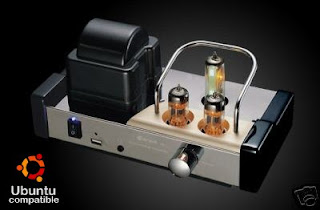During my search for a proper DAC for my gainclone I stumbled upon the Dared MP-5. It is very unique in the way that it combines USB DAC, tube pre-amp, and a (supposedly) gainclone implementation. The DAC is an older version which is 48khz so it won't be able to decode SACD or any 96khz recording. The amp is also a 13w/ch version as supposed to 50 or 60 watt LM3875 gainclones. Nevertheless the tube preamp is really appealing and even without RCA out I think I can simply tap the potentiometer to create one.
The Dared MP-5 came delivered in a quite big box. I did not expect that and it was a good sign.

It came with literally everything needed to make music. Just plug in a PC and Speakers. It also came with a white cotton gloves and brush, and you'll soon know why ...

This amp is like a piece of jewellery. Fully polished and shiny I opt to lift it from the bottom to move it around. It is also bigger than I expected and is very solid.

At the front there is a power button with blue led indicator, usb port with indicator, a volume control, and a headphone jack. At the back there are RCA line-in, switch to select usb/RCA input, and speaker connectors. The tubes are protected using a flat-black cage and it looks fine. I see people take it off but I just don't bother with it.




























